Page 471 of 723
470 Controls in detail
Loading and storing
Storage compartments in the front
passenger compartment
Glove box
The glove box can be unlocked and locked
with the mechanical key (
�page 635).
�Opening: Press glove box lid
release1.
�Closing: Push the lid up.
�Locking: Insert the mechanical key
into the glove box lock and turn it
clockwise to position3.
�Unlocking: Insert the mechanical key
into the glove box lock and turn it coun-
terclockwise to position2.Storage compartments in the front
armrest
1Storage tray/telephone* compartment
2Storage compartment
�Opening storage tray/telephone*
compartment: Press button1 and
swing armrest to left or right side.
�Opening storage compartment:
Press button2 and swing center arm-
rest upward.
1Glove box lid release
2Unlocking glove box
3Locking glove box
Page 512 of 723
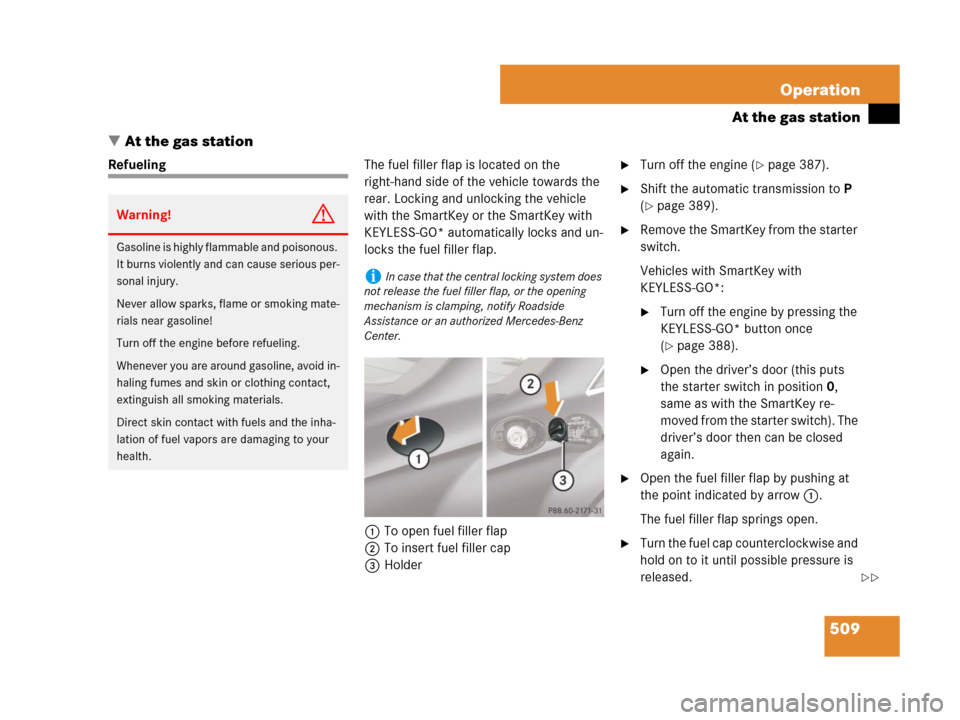
509 Operation
At the gas station
�At the gas station
RefuelingThe fuel filler flap is located on the
right-hand side of the vehicle towards the
rear. Locking and unlocking the vehicle
with the SmartKey or the SmartKey with
KEYLESS-GO* automatically locks and un-
locks the fuel filler flap.
1To open fuel filler flap
2To insert fuel filler cap
3Holder�Turn off the engine (�page 387).
�Shift the automatic transmission to P
(
�page 389).
�Remove the SmartKey from the starter
switch.
Vehicles with SmartKey with
KEYLESS-GO*:
�Turn off the engine by pressing the
KEYLESS-GO* button once
(
�page 388).
�Open the driver’s door (this puts
the starter switch in position0,
same as with the SmartKey re-
moved from the starter switch). The
driver’s door then can be closed
again.
�Open the fuel filler flap by pushing at
the point indicated by arrow 1.
The fuel filler flap springs open.
�Turn the fuel cap counterclockwise and
hold on to it until possible pressure is
released.
Warning!G
Gasoline is highly flammable and poisonous.
It burns violently and can cause serious per-
sonal injury.
Never allow sparks, flame or smoking mate-
rials near gasoline!
Turn off the engine before refueling.
Whenever you are around gasoline, avoid in-
haling fumes and skin or clothing contact,
extinguish all smoking materials.
Direct skin contact with fuels and the inha-
lation of fuel vapors are damaging to your
health.
iIn case that the central locking system does
not release the fuel filler flap, or the opening
mechanism is clamping, notify Roadside
Assistance or an authorized Mercedes-Benz
Center.
��
Page 513 of 723
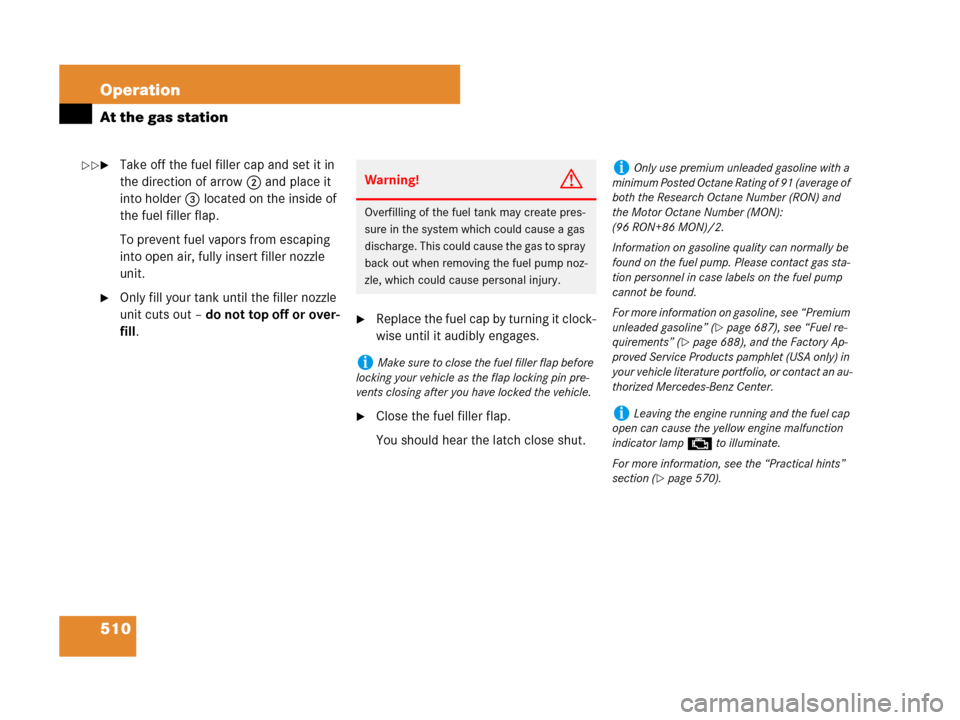
510 Operation
At the gas station
�Take off the fuel filler cap and set it in
the direction of arrow 2 and place it
into holder 3 located on the inside of
the fuel filler flap.
To prevent fuel vapors from escaping
into open air, fully insert filler nozzle
unit.
�Only fill your tank until the filler nozzle
unit cuts out – do not top off or over-
fill.
�Replace the fuel cap by turning it clock-
wise until it audibly engages.
�Close the fuel filler flap.
You should hear the latch close shut.
Warning!G
Overfilling of the fuel tank may create pres-
sure in the system which could cause a gas
discharge. This could cause the gas to spray
back out when removing the fuel pump noz-
zle, which could cause personal injury.
iMake sure to close the fuel filler flap before
locking your vehicle as the flap locking pin pre-
vents closing after you have locked the vehicle.
iOnly use premium unleaded gasoline with a
minimum Posted Octane Rating of 91 (average of
both the Research Octane Number (RON) and
the Motor Octane Number (MON):
(96 RON+86 MON)/2.
Information on gasoline quality can normally be
found on the fuel pump. Please contact gas sta-
tion personnel in case labels on the fuel pump
cannot be found.
For more information on gasoline, see “Premium
unleaded gasoline” (
�page 687), see “Fuel re-
quirements” (
�page 688), and the Factory Ap-
proved Service Products pamphlet (USA only) in
your vehicle literature portfolio, or contact an au-
thorized Mercedes-Benz Center.
iLeaving the engine running and the fuel cap
open can cause the yellow engine malfunction
indicator lamp ± to illuminate.
For more information, see the “Practical hints”
section (
�page 570).
��
Page 521 of 723
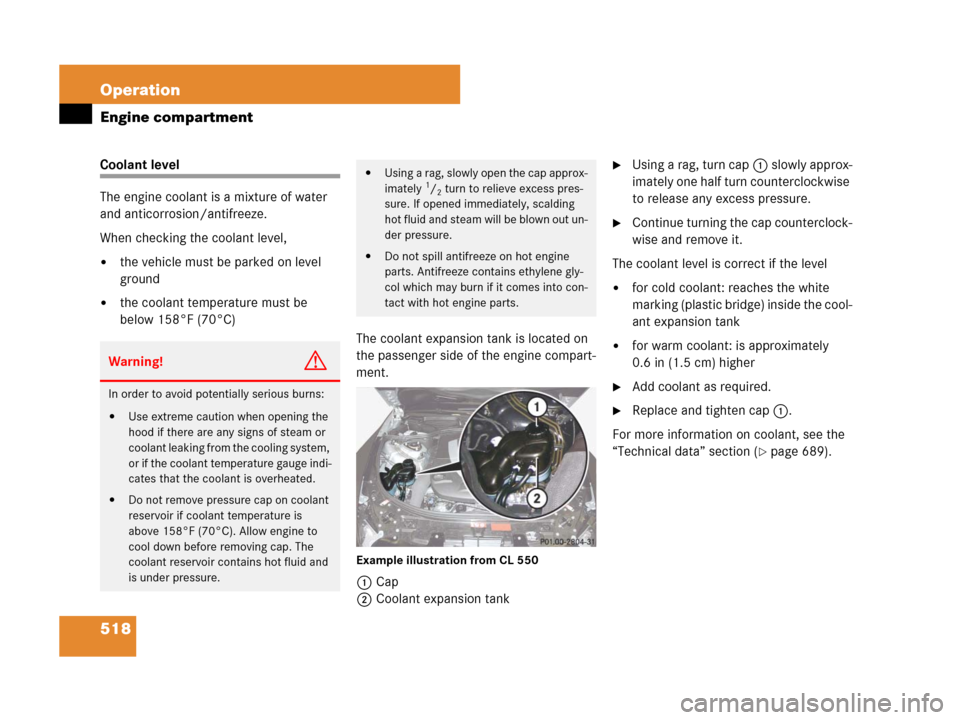
518 Operation
Engine compartment
Coolant level
The engine coolant is a mixture of water
and anticorrosion/antifreeze.
When checking the coolant level,
�the vehicle must be parked on level
ground
�the coolant temperature must be
below 158°F (70°C)
The coolant expansion tank is located on
the passenger side of the engine compart-
ment.
Example illustration from CL 550
1Cap
2Coolant expansion tank
�Using a rag, turn cap1 slowly approx-
imately one half turn counterclockwise
to release any excess pressure.
�Continue turning the cap counterclock-
wise and remove it.
The coolant level is correct if the level
�for cold coolant: reaches the white
marking (plastic bridge) inside the cool-
ant expansion tank
�for warm coolant: is approximately
0.6 in (1.5 cm) higher
�Add coolant as required.
�Replace and tighten cap1.
For more information on coolant, see the
“Technical data” section (
�page 689).
Warning!G
In order to avoid potentially serious burns:
�Use extreme caution when opening the
hood if there are any signs of steam or
coolant leaking from the cooling system,
or if the coolant temperature gauge indi-
cates that the coolant is overheated.
�Do not remove pressure cap on coolant
reservoir if coolant temperature is
above 158°F (70°C). Allow engine to
cool down before removing cap. The
coolant reservoir contains hot fluid and
is under pressure.
�Using a rag, slowly open the cap approx-
imately 1/2 turn to relieve excess pres-
sure. If opened immediately, scalding
hot fluid and steam will be blown out un-
der pressure.
�Do not spill antifreeze on hot engine
parts. Antifreeze contains ethylene gly-
col which may burn if it comes into con-
tact with hot engine parts.
Page 636 of 723
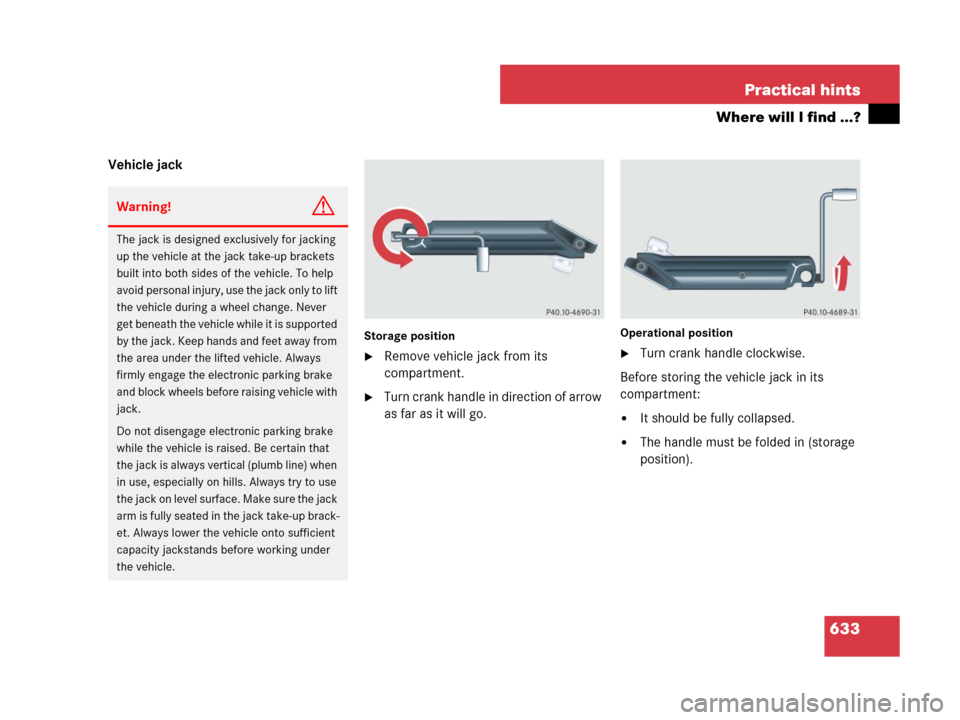
633 Practical hints
Where will I find ...?
Vehicle jack
Storage position
�Remove vehicle jack from its
compartment.
�Turn crank handle in direction of arrow
as far as it will go.
Operational position
�Turn crank handle clockwise.
Before storing the vehicle jack in its
compartment:
�It should be fully collapsed.
�The handle must be folded in (storage
position).
Warning!G
The jack is designed exclusively for jacking
up the vehicle at the jack take-up brackets
built into both sides of the vehicle. To help
avoid personal injury, use the jack only to lift
the vehicle during a wheel change. Never
get beneath the vehicle while it is supported
by the jack. Keep hands and feet away from
the area under the lifted vehicle. Always
firmly engage the electronic parking brake
and block wheels before raising vehicle with
jack.
Do not disengage electronic parking brake
while the vehicle is raised. Be certain that
the jack is always vertical (plumb line) when
in use, especially on hills. Always try to use
the jack on level surface. Make sure the jack
arm is fully seated in the jack take-up brack-
et. Always lower the vehicle onto sufficient
capacity jackstands before working under
the vehicle.
Page 637 of 723
634 Practical hints
Where will I find ...?
Minispare wheel
The Minispare wheel is stored in the com-
partment underneath the trunk floor.
1Minispare wheel with spare wheel bolts
in container on wheel rim
2Luggage bowl
3Vehicle tool kit, jack and collapsible
wheel chock
Removing the Minispare wheel
�Turn luggage bowl2 counterclock-
wise.
�Remove luggage bowl2 and vehicle
tool kit3.
�Remove Minispare wheel1.
Setting up the collapsible wheel chock
The collapsible wheel chock serves to
additionally secure the vehicle, e.g. while
changing the wheel.
1Tilt the plates upward
2Fold the lower plate outward
3Insert the plate�Tilt both plates upward1.
�Fold the lower plate outward2.
�Guide the tabs of the lower plate all the
way into the openings of the base
plate3.
For information on where to place wheel
chocks when changing a wheel, see “Lift-
ing the vehicle” (
�page 650).
Page 638 of 723
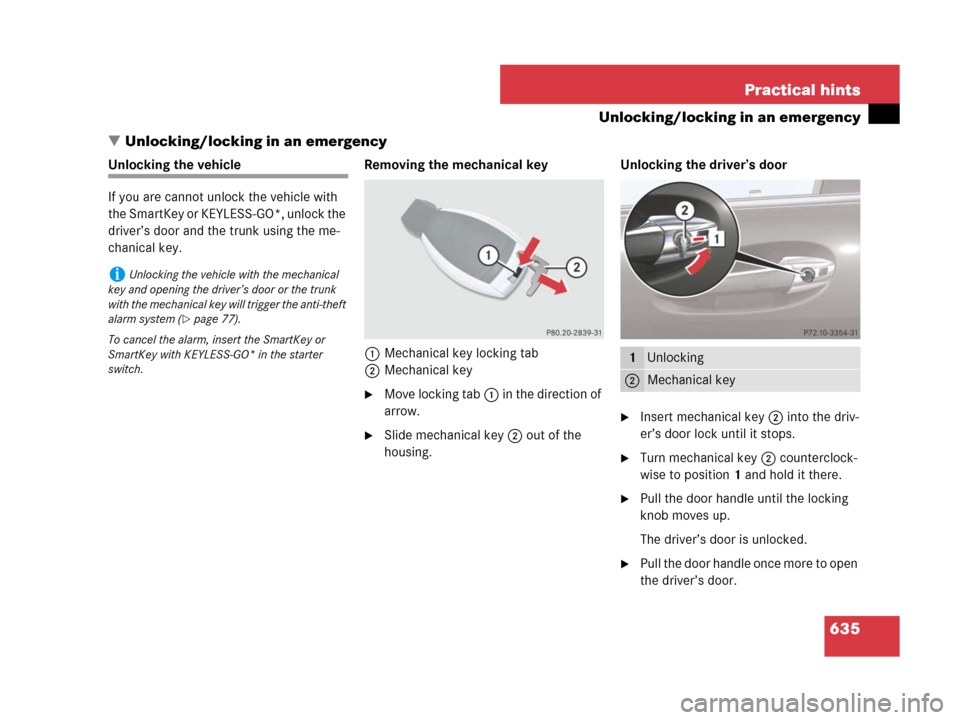
635 Practical hints
Unlocking/locking in an emergency
�Unlocking/locking in an emergency
Unlocking the vehicle
If you are cannot unlock the vehicle with
the SmartKey or KEYLESS-GO*, unlock the
driver’s door and the trunk using the me-
chanical key. Removing the mechanical key
1Mechanical key locking tab
2Mechanical key
�Move locking tab1 in the direction of
arrow.
�Slide mechanical key2 out of the
housing.Unlocking the driver’s door
�Insert mechanical key2 into the driv-
er’s door lock until it stops.
�Turn mechanical key2 counterclock-
wise to position1 and hold it there.
�Pull the door handle until the locking
knob moves up.
The driver’s door is unlocked.
�Pull the door handle once more to open
the driver’s door.
iUnlocking the vehicle with the mechanical
key and opening the driver’s door or the trunk
with the mechanical key will trigger the anti-theft
alarm system (
�page 77).
To cancel the alarm, insert the SmartKey or
SmartKey with KEYLESS-GO* in the starter
switch.
1Unlocking
2Mechanical key
Page 639 of 723
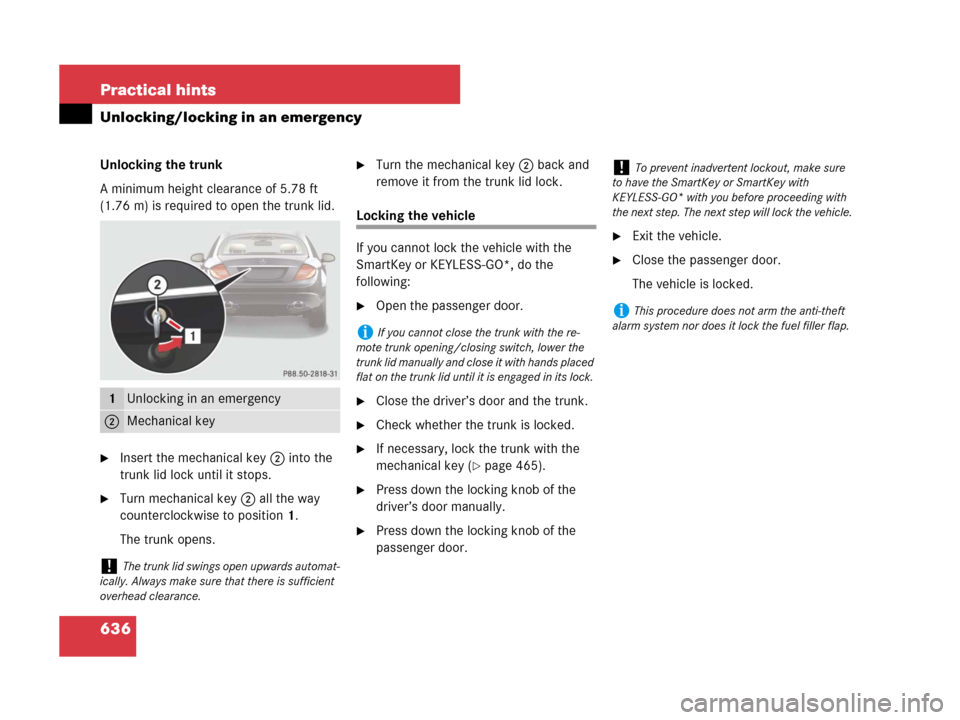
636 Practical hints
Unlocking/locking in an emergency
Unlocking the trunk
A minimum height clearance of 5.78 ft
(1.76 m) is required to open the trunk lid.
�Insert the mechanical key2 into the
trunk lid lock until it stops.
�Turn mechanical key2 all the way
counterclockwise to position 1.
The trunk opens.
�Turn the mechanical key2 back and
remove it from the trunk lid lock.
Locking the vehicle
If you cannot lock the vehicle with the
SmartKey or KEYLESS-GO*, do the
following:
�Open the passenger door.
�Close the driver’s door and the trunk.
�Check whether the trunk is locked.
�If necessary, lock the trunk with the
mechanical key (
�page 465).
�Press down the locking knob of the
driver’s door manually.
�Press down the locking knob of the
passenger door.
�Exit the vehicle.
�Close the passenger door.
The vehicle is locked.
1Unlocking in an emergency
2Mechanical key
!The trunk lid swings open upwards automat-
ically. Always make sure that there is sufficient
overhead clearance.
iIf you cannot close the trunk with the re-
mote trunk opening/closing switch, lower the
trunk lid manually and close it with hands placed
flat on the trunk lid until it is engaged in its lock.
!To prevent inadvertent lockout, make sure
to have the SmartKey or SmartKey with
KEYLESS-GO* with you before proceeding with
the next step. The next step will lock the vehicle.
iThis procedure does not arm the anti-theft
alarm system nor does it lock the fuel filler flap.